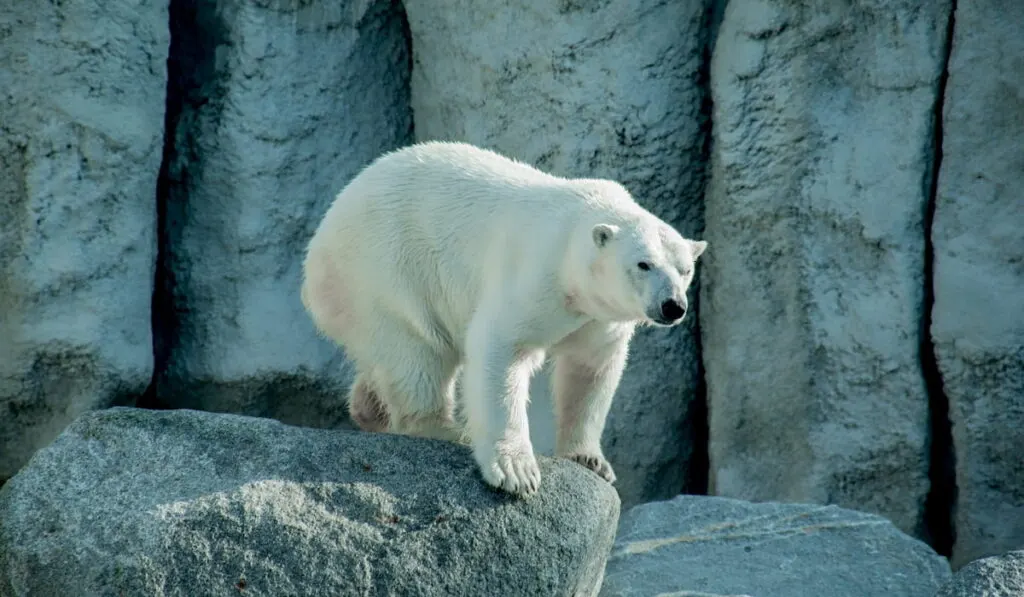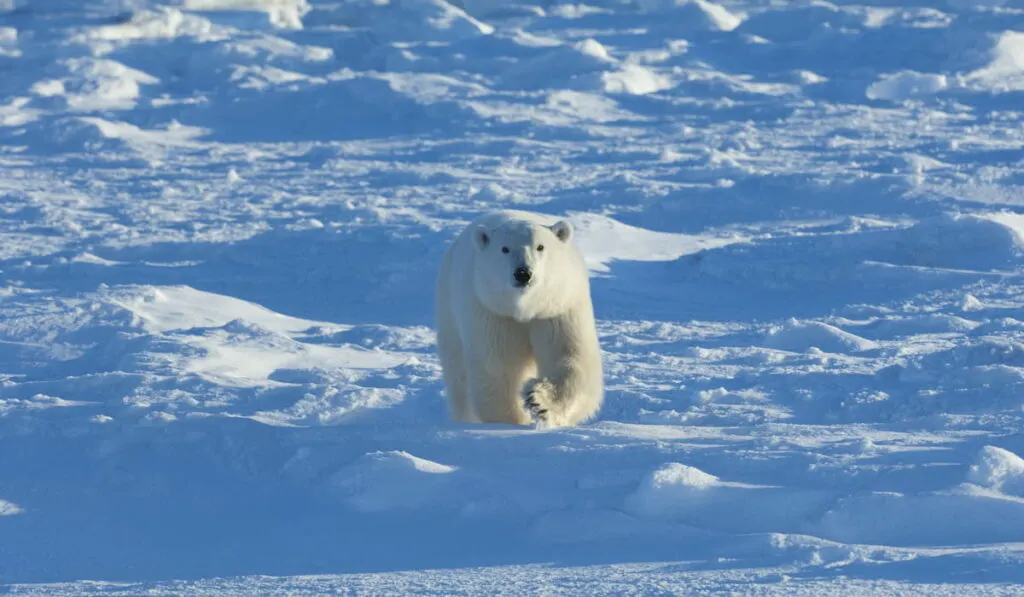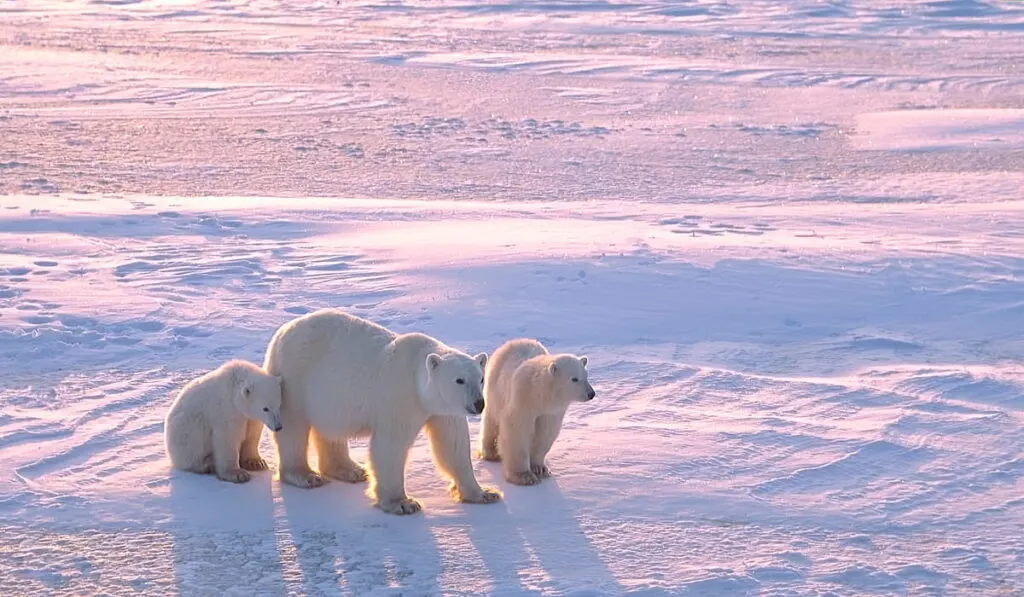When you think of black bears and brown bears, you often think of them hibernating in the winter months. So, it is natural to extend that line of thinking to the big, white polar bears, too. But thanks to different habitats and lifestyles, it’s a more complicated question than just one of species similarities: do polar bears in fact hibernate?
In the most general sense of the word, no, polar bears do not hibernate. While there are ebbs and flows in their routines and activity levels, seasonally and otherwise, polar bears do not actually hibernate like their other bear cousins.

There are a number of reasons why polar bears don’t meet the definition of hibernation – and why they don’t really need to.
Table of Contents
Regular Activity
Typically, polar bears tend to follow certain patterns of activity. On a daily basis, you can expect polar bears to behave similarly to working humans: they are most active in the first third of the day, and taper off, becoming least active in the final third of the day.
According to Sea World, much of their time is spent hunting, too. Adult female polar bears with cubs can spend anywhere from 19% to 38% of their waking hours’ hunting, while adult males use 25% to 40% of their time to hunt, fluctuating with the seasons.
When polar bears are chasing prey, they can reach running speeds of up to 25 mph in their pursuits.
If polar bears are not hunting, they are most likely resting to conserve energy. Though not hibernation, in off-season times for hunting, some polar bears can remain resting for up to 87% of their time.
When it is warm, polar bears will often spend their downtime sprawled out on the ice or sleeping up on snow piles. During colder times, they may seek shelter or will rest more tightly curled up to save body heat.
Why Aren’t Resting Polar Bears Considered Hibernating
Hibernation has a scientific definition as being an organism in a state of inactivity, metabolic decline, slowed breathing and slow heart rate and low body temperature fluctuations that remain constant on a seasonal basis. (source)
Only endothermic beings (animals that generate and maintain their heat internally) can achieve true hibernation, as only their bodies can have temperatures and metabolic rates dictated and affected by that. Some animals that are not endothermic can still be dormant for certain periods, but they do not achieve true hibernation.
In that vein, what defines true hibernation for mammals is a large decrease in both body temperature and heart rate, and a sleep that is defined by the animal staying for an extended period of time in the den. (source)
Aside from the physical factors not being met, adult polar bears (excluding pregnant females) do not even hole up in dens at all.
Some Bears Are Great Hibernators
Black bears, for instance, are considered by animal researchers to be some of the best hibernators, hands down. (source) Their unique bodies are actually closed systems, meaning they can reduce their need for food and nutrients down to pretty much only needing oxygen.
Their metabolisms slow almost all the way down so that their heart rates and core temperatures bring them into a coma-like state. They are not expending much energy, save what’s needed to breathe and pump blood, albeit at a far lower rate than during active months.
Why the Polar Bear Is Different from Bears That Hibernate
Polar bear bodies do not drop all the way down like that. Their temperatures hardly ever fluctuate, and certainly never dip low enough to hibernate. Though there are some circumstances in which their heart rate can drop, it is never enough to put them in so sound a sleep they are technically hibernating.
Walking Hibernation

Though adult male polar bears and non-pregnant females do not experience a hibernation state, they can mimic some characteristics. For instance, during times of food scarcity, their bodies can go into a “walking hibernation” in which they remain active and awake, but their metabolisms modify to a more hibernation-like setting, allowing them to use fat and energy reserves to stay sustained off of little to no food. (source)
In fact, in the 1980s, researchers took notice of this “light hibernation” and further classified times of lean feeding and moderate activity levels.
Since this was not full hibernation but was a marked decrease in eating and activity, they called it a “walking hibernation”, which, until then, was a term used to describe the transitional state black and brown bears experienced after coming out of full hibernation before their bodies fully returned to normal. (source)
Chemical Changes in Hibernating Polar Bears
Walking hibernation can be scientifically proven through the levels of two compounds. Urea, found in the blood, decreases in quantity when a bear is not eating and is instead using its fat reserves.
Creatinine is also found in the blood and would still remain stable. Blood samples taken from recently emerged from hibernation black bears were taken and were shown to match the sample of polar bears experiencing that “light hibernation”, proving them to be the same physiological state.
Scientists also found that polar bears could go in and out of “walking hibernation” pretty easily, depending on if they were fasting or eating regularly. Their bodies react quickly, with adjustments happening after only a handful of days.
Temperature Changes in Polar Bears with Walking Hibernation
Researchers also measured polar bear body core temperature against metabolic activity (as polar bears ate more, the higher their active metabolisms and temperatures were).
In their studies, they found that there were no sharp or sudden body temperature changes to signal a polar bear entering walking hibernation. Rather, there were only gradual declines in body temperature, meaning they were eased into seasons of walking hibernation.
The body temperature drops are minor, meaning their walking hibernation is not a very deep state. (source)
Polar Bear Adaptations for Surviving Harsh Weather
Scientists have also found that polar bears actively undergo some physiological changes heading into the leaner months when they reincorporate some chemicals into their bodies that would normally be excreted as waste.
This is a preventative measure that sets them apart from people, as it prevents some of the physical damages that a human would suffer from similar extreme fasting and rapid weight loss that these bears will experience during their walking hibernations.
Some bears have even been observed taking a proactive route to cool their cores by swimming in icy water before the walking hibernation season.
Surviving the Coldest, Darkest Season
Though other bears and large mammals traditionally make it through frozen times by hibernating, that’s not the only way to stay warm and well-fed.
Despite a common misconception of total darkness during polar winter months, there is still some dim light that polar bears make use of when hunting.
Similarly, their strong sense of smell allows them to hunt and stay fed during these winter months. (source)
Also, polar bears will still be eating more as harsher months approach, so they are prepared to survive as needed during that time. (source) A good rule of thumb for going into winter is the more fat the better.
When access to seals and other hunted food is scarce, polar bears need to dip into their reserves while still maintaining enough fat and energy to let them be back in hunting shape when it’s time to hunt for their dinners again.
Interestingly, while living off those reserves, it means the bears are technically starving themselves, though they are metabolizing to stay alive.
As fat stores are worked through, they lose an average of one kilogram a day. And, though they are not hunting, polar bears may graze on berries, kelp or small eggs to help them maintain energy during those leaner times.
Though, since hibernation is not a physical part of a polar bear’s routine, that means that a threatened environment and climate truly affects them.
They need to hunt seals in order to eat during warmer months and save up enough energy reserves. To do this, polar bears utilize sea ice, which, as temperatures soar, disappears. If polar bears can’t reach their prey, they can’t eat enough to hold them over through seasons of loss of food.
Polar Bear Genetics
Another thing setting apart polar bears from brown and black bears, aside from habitat, comes down to adaptations and genetics. Since one of the main reasons for hibernation is to conserve energy and keep a body warm enough to survive, gene functions related to heat and energy play a big role.
Researchers looking into genetic adaptations have shown that nitric oxide plays a big part in energy metabolism.
It is known that cells take in nutrients and transform them into energy. But, from there, something called adaptive thermogenesis (or, rather, non-shivering thermogenesis) has cells produce heat instead of energy depending on environment and diet triggers. (source)
It was found that higher values of nitric oxide production are found in black and brown bears and lower in polar bears.
This means that the higher amount found in black and brown bears block energy production over heat production as colder months come. Polar bears, though, have lower levels and so maintain a higher level of energy throughout the year.
Simply put, brown and black bears have cell production changes that result in them simply not producing enough energy to stay awake and active throughout the winter, causing them to need to hibernate. Polar bears, though, don’t experience those same disruptions and so can maintain regular activity levels.
“Hibernation” Exceptions

The exception to the “polar bears don’t hibernate rule” can be found in the pregnant females. According to the Maryland Zoo, expectant polar bear mothers will dig a snow den (often impressive feats, as dens can be up to three feet tall and even ten feet long), in which to rest and give birth and can occupy them for up to three months.
After birth, the mother will nurse and protect her cubs, staying fully in the den, until the babies are ready to leave. During this time, a sort of hibernation is achieved, as the mother will not only stay in the den, but also will not eat.
Female polar bears in this state live off their fat reserves and can go up to eight months without eating.
It’s important to note that this is still not called hibernation, but rather is referred to as “denning”. Rather than going into a low heart rate state and not eating due to low food sources, pregnant polar bears mostly maintain their heart rate and body temperature so that they can keep their cubs warm, in turn.
While their heart rate can drop from a typical 46 beats per minute to around 30 beats per minute, their internal temperature rarely fluctuates.
At most, the polar bear mothers may experience a two or three-degree difference (either staying at their regular 98.6°F or dropping at most to around 95°F).
This is important because a higher body temperature is necessary for withstanding the stresses of pregnancy and delivering safely, as well as nursing and raising cubs successfully.
When mama bears are hibernating, they do not eat or drink – and they do not even urinate! However, it is known that these bears maintain stability in mineral levels and a consistent body mass.
Plus, their blood composition and metabolites remained fully maintained. What makes this a surprising feat is the fact that an animal this large is losing sometimes up to half its body mass while denning, but still staying metabolically stable.
Any deficiencies that occur from not taking in water are made up from catabolizing fat. This keeps stable fluid levels in their bodies, keeping them healthy and alive. And, by recycling proteins and their urine, the ability to not urinate for months on end means they are able to avoid muscle atrophy during these more dormant periods.
While polar bears are not natural hibernators, they do adapt and change with the environment and with physical changes. During harsher temperatures and periods of food scarcity, their metabolisms can adjust to near-hibernation levels that allow them to survive off of reserved fats. When pregnant, adult females get close to hibernating in order to safely birth. Though traditional hibernation simply is not a part of a polar bear’s cycle, they do survive in cold months and adapt as needed.
